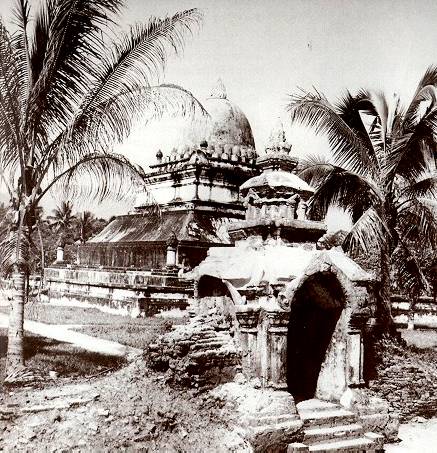|
| Main Contents | Luang Prabang and Its Art | Furniture and Statuary | Beliefs and Religions | Population and Habitat |
Vat Vixun: That Kak Mo (E.EE.O.1932) |
still |
| Vat
Vixun: That Kak Mo seen from Vat Aham (E.EE.O.1932) Before its partial destruction in the fire that blazed through the town in 1887, and prior to its restoration by King Sakharine Khamsouk in 1898, Vat Vixun was one of the most imposing monasteries of the old royal town. Built between 1512 and 1515, during the reign of King Vixun Harath, legend has it that no less than 4,000 trees were used for its construction. 12 pillars each 30 meters high and 1.30 meters in diameter, supported its roof, each and and every one procured from a different forest. Originally built entirely of carved wood, the viharn is now of masonry, but the general shape and character of the former structure is more or less retained, particularly the window formation.Vat Vixun is in the style featuring a peripheral nave and lean-to porch in front. The central four-sided roof features a central spike with seventeen prasat and three-headed naga. Displayed inside the viharn is one of the biggest Buddha statues in stucco and gilded masonry in Luang Prabang. A most beautiful collection of stelai statues and ancient objects, especially XIth and XIIth century Khmer pieces which can be viewed today at the National Museum; was to be found at the Vat Vixun between 1942 and 1975; when it was the museum of religious arts. The surrounding walls of Vat Vixun are punctuated by four gates in the form of three-tiered prasat and crowned with a bowl of lotus flowers. On the temple grounds stands a square monument surmounted by a semi-spherical dome - That Pathoum, the ‘Stupa of the Great Lotus', better known to the people of Luang Prabang as That Mak Mo, the ‘Watermelon Stupa94. Erected between 1514 and 1515, its semi-spherical form is of such an exceptional type that no other monument of its kind can be found where else in Laos, not even in other Indochina countries. After more than three years of work, the monument's reconstruction was completed in 1932. The semi-spherical body stands on various tiers of differing shapes and is crowned by an Usnisa (cranial protuberance) of the Laotian Buddhist type.
|
SEAsite Laos | Overview | History | Art & Culture | Language | Literature |
Gallery | Folklore | Other Topics | Links | SEAsite |
|
2003 SEAsite
Laos. Treasures of Luang Prabang |

 i
i